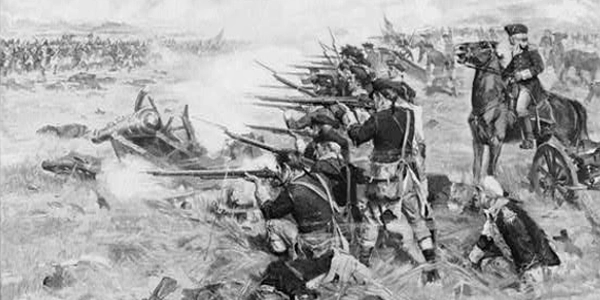
Photo above: Present day photo of George Washington's headquarters at the Battle of Brandywine, Chadd's Ford, Pennsylvania.
America's Best History Spotlight
On this page we're going to Spotlight the lesser known historic sites and attractions that dot the history landscape across the USA and are worth a visit if you're in their area. And while they may be lesser known, some are very unique, and will be that rare find. You'll be, at times, on the ground floor, or maybe even know something others don't. It'll be fun. Visit them.

Battle of Brandywine
It's a very odd fact that the largest battle of the American Revolution is relegated to a page called lesser known history. However, it's true. While the Civil War battlefields in the largest ever category are household names; Gettysburg, Antietam, Shiloh, Fredericksburg, the Battle of Brandywine held south of Philadelphia only three months before Washington would march into Valley Forge, is largely unknown. In fact, it was so little thought of, that in 2009, the Pennsylvania State Museum commission was going to close it. That did not happen, as a partnership with a friends group has kept the site vibrant. But it's history deserves better, and it's status as lesser known historic site needs to change. With groups such as Campaign 1776 now attempting (this is the Civil War Trust's new American Revolution division) to preserve more American Revolution landscape, perhaps the one day struggle to keep the British from moving closer and closer to Philadelphia will garner more attention. And one thing's for certain, it definitely should. Image above: Drawing of the Battle of the Brandywine by F.C. Yohn, 1898, courtesy Library of Congress.
- Info
- What is There Now
- History Nearby
-

Battle of Brandywine
In July of 1777, General Sir William Howe of the British Army had sailed from New Jersey to Elkton, Maryland, attempting and succeeding to march north toward Philadelphia, meeting with the major part of General Washington's Continental Army on September 11, 1777. The large fight, by American Revolution standards, included approximately 15,000 troops on both sides. It would not be a good day for the fledgling American Army. Without scouts to detect movement by Howe's Army to the right flank, the stiff battle became a defeat for George, with only a late fight by Greene's division allowing a retreat back toward the city. But the city would not be long for Washington's rule, as by September 26, the British held Philadelphia, and after some valiant fights at places like Paoli and Fort Mifflin, General George Washington and his troops would make it to their winter quarters at Valley Forge.
While it had taken Howe 34 days to take his 20,000 troops from New Jersey to Maryland, the defeats Washington would take in the battles and skirmishes before and after Brandywine would be swift. The British would hold Philadelphia until June 1778, and left on their own volition. It wouldn't be dumb to ask why and it would be pertinent to say thanks, because in many ways, that decision would begin to lead to better days ahead for Washington in his quest to win a new nation.
Today you can see the exhibits and a film at the visitor center, tour George Washington's headquarters, site other historic structures, and walk across the battlefield land. And while you take that trek, just remember that the largest battle of the American Revolution needs to be remembered and elevated to a higher position in the annals of American history sites, so that next year, it would not qualify for this page.
Image above: Painting by Frederic Stevenson, 1856, depicting the farmhouse of Benjamin Ring, used as the headquarters for General George Washington during the Battle of Brandywine. Courtesy Library of Congress.
-
Brandywine Battlefield State Park
What's There
Visitor Center, Museum Shop, Film, and Washington's headquarter tours run by the Brandywine Battlefield Park Associates. Brandywine Battlefield became a Pennsylvania State Park in 1949.
Fifty acres of the park is open to visitors.
How Much to Visit
Adults - $8. AAA, AARP, Seniors - $7. Children (6-17) $5. Admission price includes film, museum, and headquarters tour.
Hours Open
Early March to early December - 9:00 to 4:00, except Sunday 12:00 to 4:00. Closed Monday all year. Closed other days of the week during the spring and fall. Check the website below for details.
Where Is It Located
Brandywine Battlefield State Park is located on US Route 1, 25 miles west of Philadephia. Address is 1491 Baltimore Pike, Chadd's Ford, PA 19317.
Website - Brandywine Battlefield Park Associates
State Website - Brandywine Battlefield State Park
-
Southeast Pennsylvania Historic Sites
So what else is there to do near Brandywine Battlefield. Well, there's the Brandywine River Museum of Art and Longwood Gardens.
Brandywine Valley Tourism
Other American Revolution sites exist in the Philadelphia area as well, including the well known, Valley Forge, and other lesser known, Fort Mifflin.
Valley Forge National Historic Park
Fort Mifflin
Photos, History, and More Spotlights

What Precipitated the Battle
During the early summer of 1777, British General William Howe was located in New York City with a large force that many thought was destined to go north and meet General Burgoyne in upstate New York. But that wasn't the plan. He would sail south with 266 ships and 20,300 men below Philadelphia and threaten the city from there. When the ships were noticed off the New Jersey coast, Washington shifted his troops south as well.
What Caused the Defeat
General Howe, using similar tactics as the Battle of Long Island, split his forces in two; 7,100 with Hessian General William von Knyphausen to the east, and 8,500 men flanking Washington's right under Cornwallis. With the fords on the path undefended and Washington ignoring an earlier warning that there might just be a flanking movement, the outcome of the Battle of Brandywine was foretold.
Photo above: Painting by Howard Pyle named "Nation Makers", now part of the Brandywine Museum collection. Source: Wikipedia Commons.
American Revolution Timeline - Philadelphia Campaign, Fall 1777
August 25, 1777 - British under Howe leave Sandy Hook, New Jersey on July 23 for Elkton, Maryland, shuttling 20,000 troops to their landing in the north Chesapeake Bay.
September 3, 1777 - Battle of Cooch's Bridge, Delaware. Skirmish between German troops fighting for Britain and light infantry under Maxwell. Noted as the battle where the American flag was first flown.
September 11, 1777 - Battle of Brandywine.
September 16, 1777 - Battle of the Clouds (Malvern).
September 20, 1777 - Battle of Paoli
September 22-26, 1777 - George Washington, thinking the British were heading west toward his supply base near Reading, sites his army at Camp Pottsgrove.
September 26, 1777 - British Army under General Howe occupy Philadelphia with no opposition, taking advantage of Washington's west mistake.
October 4, 1777 - Battle of Germantown.
October 22, 1777 - Battle of Red Bank.
October to November 15, 1777 - Battle of Fort Mifflin
December 5-8, 1777 - Battle of White Marsh/Edge Hill.
December 11, 1777 - Battle of Matson's Ford (Conshohocken).
December 19, 1777 - George Washington and Continental Army enter Valley Forge for the winter encampment. Washington would leave Valley Forge on June 19, 1778.

Photo above: Image of a Continental soldier at Valley Forge during the winter after their defeat at the Battle of Brandywine. Courtesy Library of Congress.
About
America's Best History where we take a look at the timeline of American History and the historic sites and national parks that hold that history within their lands.
Photos courtesy of the Library of Congress, National Archives, National Park Service, americasbesthistory.com and its licensors.



